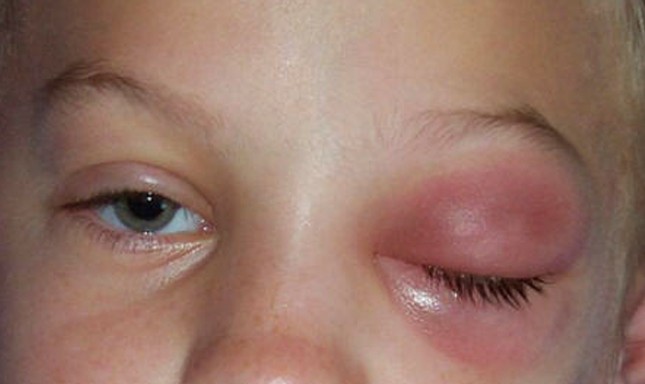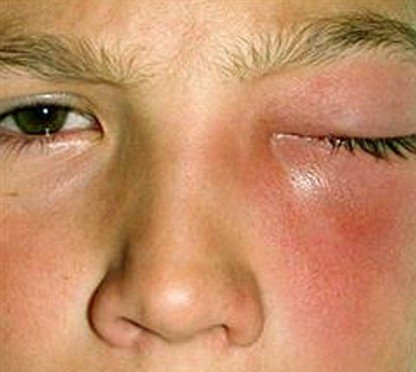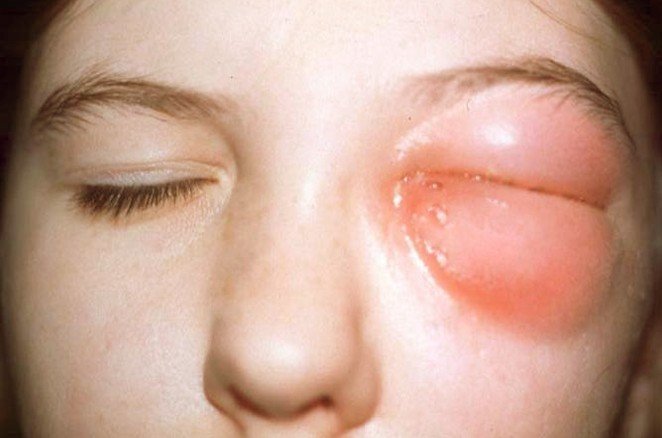Orbital Cellulitis
Last reviewed by Dr. Raj MD on January 12th, 2022.
What is Orbital Cellulitis?
This is an infection of the eye and the orbit that happens suddenly. The orbit is the underlying structure in your eye socket that supports your eye. Orbital cellulitis not only affects the tissues around your eye but it can also affect your eyebrow, cheek, and eyelid. It is a dangerous infection and can cause problems that are long lasting. When a person has general cellulitis it means that they have a bacterial infection that involves the inner layers of their skin. Although anyone regardless of age, gender, or race can get orbital cellulitis it is more common in children under the age of seven.
Pictures of Orbital Cellulitis
Picture of Orbital Cellulitis in a small child
Picture of Orbital Cellulitis in Adult
Orbital Cellulitis Picture – Inflammation of the eye tissue
Symptoms of Orbital Cellulitis
There are many different symptoms that can indicate orbital cellulitis, which can include:
- Redness and swelling around your eye, which are the most common symptoms
- Restricted eye movement that can be difficult or painful
- Bulging eye due to the pressure from the infection causing orbital cellulitis
- Fever, usually 102 degrees F or higher
- Painful swelling of your lower and upper eyelid and possibly your cheek and eyebrow
- Eye pain, especially if you move the eye
- A general feeling of being ill
- You eyelid could be shiny, purple or red
- Sudden vision loss
- Discharge
- Lethargy
If it is periorbital cellulitis your eye can become so swollen that you cannot open your eye.
Causes of Orbital Cellulitis
Orbital cellulitis is caused by an infection around or in your eye with a bacterium like staph. There are also risk factors that can cause orbital cellulitis, which include recent surgery, trauma, recent upper respiratory infection, or having a history of chronic or acute bacterial sinusitis, which is an infection of your sinuses. In children with orbital cellulitis it is commonly from a sinus infection, often the Haemophilus influenzae B (HIB) but this cause is rare now due to the HIB vaccine. It can also be caused by beta-hemolytic streptococci, Streptococcus pneumoniae, and Staphylococcus aureus bacterias. The infection is spread into your eye socket through your blood or from the adjacent sinuses.
Diagnosis
It is normally diagnosed based on the symptoms you have along with medical tests or medical imaging. One medical test the physician might have done is to do a bacterial culture of the fluid that is draining from your eye. The medical imaging tests are done to visualize your eye in its socket. For this medical condition, you will generally be sent to an ophthalmologist for a second opinion before a final diagnosis is made. This is done to rule out any similar conditions such as periorbital cellulitis. This medical condition involves the tissues around your eye and includes your eyelid.
How to treat Orbital Cellulitis?
When a person has orbital cellulitis it is normally treated with antibiotics. It may be infused through an IV for rapid effect. It will usually mean that you will have to be hospitalized. In some cases of orbital cellulitis in order to relieve the pressure on your eye and to drain an abscess that you sometimes have with this medical condition it may be necessary to have surgery. Orbital cellulitis is irritating but is treatable if the physician or ophthalmologist works promptly. If there is any delay in treatment it could result in the spread of infection to your brain that can result in meningitis or brain abscess or loss of vision. This is especially true in children as orbital cellulitis can become worse very quickly and if not treated right away it can lead to blindness.
If you have surgery you will be given prophylactic antibiotics afterwards to help prevent infection. It is very important that you finish the antibiotics to help reduce the risk of another infection, especially in those who are experiencing sinusitis.
Complications
In addition to blindness, possible brain abscess, and meningitis, you may also have:
- A formation of a blood clot in a cavity at the base of your brain called cavernous sinus thrombosis
- Hearing loss
- Blood infection, also called septicemia
- Optic nerve damage
- Some vision loss
Prevention
In order to prevent orbital cellulitis you should make sure that you wash your hands and keep them away from your eyes as much as possible. You should also make sure that you are washing your face. For a child they should get the HIB vaccine to help prevent this infection. You should throw away any contact lenses or makeup products that you were using before you developed orbital cellulitis because they could be infected with the bacteria that cause this medical condition. Using them could cause another infection.
Prognosis
The prognosis is good to recover from orbital cellulitis without problems or complications if you receive prompt medical treatment.



